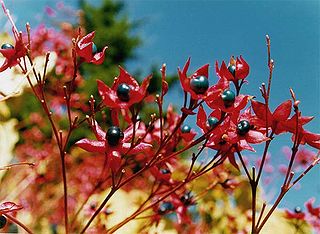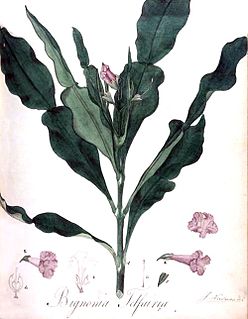
Colubrina is a genus of about 30 species of flowering plants in the family Rhamnaceae, native to warm temperate to tropical regions of Africa, the Americas, southern Asia, northern Australia, and the Indian Ocean islands. Common names include nakedwood, snakewood, greenheart and hogplum. The generic name is derived from the Latin word coluber, meaning "snake", and refers to the snake-like stems or stamens.

Clerodendrum is a genus of flowering plants formerly placed in the family Verbenaceae, but now considered to belong to the Lamiaceae (mint) family. Its common names include glorybower, bagflower and bleeding-heart. It is currently classified in the subfamily Ajugoideae, being one of several genera transferred from Verbenaceae to Lamiaceae in the 1990s, based on phylogenetic analysis of morphological and molecular data.
René Paul Raymond Capuron was a French botanist. Capuron was responsible for an extensive amount of work on the tree flora of Madagascar. Several tree taxa with the specific epithet of capuronii honor his name, examples being Podocarpus capuronii and Schizolaena capuronii.
Phylloxylon is a genus of flowering plants in the Indigofereae tribe of the family Fabaceae. There are seven species, all endemic to Madagascar.
Acropogon is a genus of flowering plants in the family Malvaceae. The genus is endemic to New Caledonia. It contains around 25 species. Its closest relatives are Australian genera: Argyrodendron, Brachychiton and Franciscodendron.

Nesogordonia is a genus of flowering plants. It ranges across tropical Africa, Madagascar, and the Comoro Islands. The majority of species are endemic to Madagascar.
Ludia is a genus of flowering plants in the family Salicaceae.

Martellidendron is a genus of flowering plants in the family Pandanaceae, native to the Seychelles and Madagascar. They resemble palms, but are not closely related to palms. The genus Martellidendron, was previously recognized as a section of the genus Pandanus in 1951 by Rodolfo Emilio Giuseppe Pichi-Sermolli, Then as a subgenus in 1974. It was finally separated out in 2003 on the basis of phylogenetic studies that used chloroplast DNA sequence data.

Capitanopsis is a genus of plants in the family Lamiaceae, first described in 1916. It contains six known species, all endemic to Madagascar.

Sapindoideae is a subfamily of flowering plants in the soapberry family, Sapindaceae. It includes a number of fruit trees, including lychees, longans, rambutans, and quenepas.
Forcipella is a genus of flowering plants in the family Acanthaceae, with all species native to Madagascar.
Gereaua is a monotypic genus of flowering plants belonging to the family Sapindaceae. It only contains one species, Gereaua perrieri(Capuron) Buerki & Callm.
Colea is a genus of flowering plants belonging to the family Bignoniaceae.
Paracorynanthe is a genus of flowering plants belonging to the family Rubiaceae.
Phyllarthron is a genus of flowering plants belonging to the family Bignoniaceae.

Rhodocolea is a genus of flowering plants belonging to the family Bignoniaceae.
Pseudocorchorus is a genus of flowering plants belonging to the family Malvaceae.
Ivodea is a genus of flowering plants belonging to the family Rutaceae.






